#Plant molecular biology
Text
"A company in France has developed genetically-enhanced houseplants that remove 30 times more indoor air pollutants than your normal ficus.
Paint, treated wood, household cleaners, insulation, unseen mold—there is a shopping list of things that can fill the air you breathe in your home with VOCs or volatile organic compounds. These include formaldehyde and other airborne substances that can cause inflammation and irritation in the body.
The best way to tackle this little-discussed private health problem is by keeping good outdoor airflow into your living spaces, but in the dog days of summer or the depths of a Maine winter, that might not be possible.
Houseplants can remove these pollutants from the air, and so the company Neoplants decided to make simple alterations to these species’ genetic makeup to supercharge this cleaning ability.
In particular, houseplants’ natural ability to absorb pollutants like formaldehyde relies on them storing them as toxins to be excreted later.
French scientists and Neoplants’ co-founders Lionel Mora and Patrick Torbey engineered a houseplant to convert them instead to plant matter. They also took aim at the natural microbiome of houseplants to enhance their ability to absorb and process VOCs as well.
The company’s first offering—the Neo P1—is a Devil’s ivy plant that sits on a custom-designed tall stand that both maximizes its air-cleaning properties and allows it to be watered far less often.
Initial testing, conducted by the Ecole Mines-Telecom of Lille University, shows that if you do choose to shell out the $179 for the Neo P1, it’s as if you were buying 30 houseplants. Of course, if you went for the budget route of 30 houseplants, you’d have to water them all.
The founders pointed out in an interview done with Forbes last year that once they settled on the species and fixed the winning genetic phenotype, the next part of the process was just raising plants, the same activity done in every nursery and florist in every town in Europe."
Deliveries for the P1 are estimated for August 2024.
-via Good News Network, November 6, 2023
--
Note: I'm not a plant biologist, but if this works the way the company's white paper says it does, holy genetic engineering, Batman.
(Would love to hear thoughts from anyone who is a plant biologist or other relevant field!)
#plant biology#superplant#pollution#indoor plants#plantblr#house plants#plantlife#hope posting#solarpunk#small business#genetic engineering#genetics#molecular biology#microbiome#respiratory health#france#ivy
554 notes
·
View notes
Text

A close up look at DNA extraction from Medicago leaves ☘️. The small plastic tube I’m holding shows 3 distinct layers. The tube contains pulverised frozen leaf tissue mixed with CTAB buffer and chloroform. This chemical mixture causes 3 distinct layers to form in the tube based on their density. The dissolved DNA is in the upper layer (the least dense) where I can collect it and transfer it to a new tube for further purification with isopropanol and ethanol.
#katia plant scientist#botany#plant biology#plant science#plants#biology#molecular biology#science#mad science#laboratory#labcore#sciencecore#women in science#eppendorf tube#sample#dna#medicago#chlorophyll
61 notes
·
View notes
Text
SUBSTANTIVE EDITING FOR STRUCTURE, ORGANIZATION, AND LOGICAL FLOW
Our Substantive Editing service ensures that your manuscript goes through a thorough language and structural edit so that you receive a well-written, logically structured manuscript, increasing your chances of publication in your target journal.
#English#language editing#research#journal#manuscript#paper#high impact factor#publishing#international#science#biology#biochemistry#molecular biology#plant#animal#earth#medicine#pharmacy#surgery#engineering#technology#academics#economics#management#university#research institution#hospital#funding#native speaker#translation
0 notes
Text
Top Ukrainian female Scientists, Doctors, Mathematicans, Economists, Artists, Athletes, Leaders, Astronauts, Military Leaders, etc.

The Ukrainian mathematician Maryna Viazovska who won Fields Medal — the highest honor for a mathematician.
Selected few famous Ukrainian scientists
We decided to talk about outstanding Ukrainian women who've changed and continue to change the world of science to show that girls can do anything.
Maryna Viazovska, a mathematician
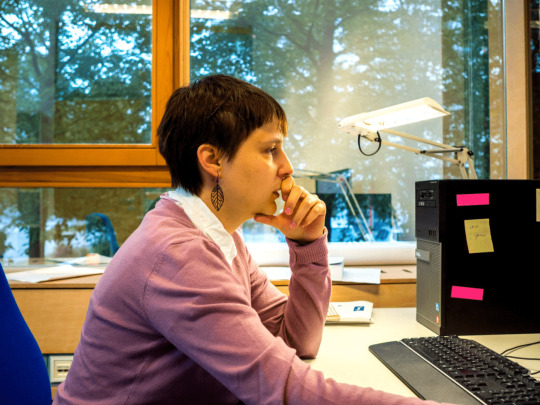
Ukrainian scientist, doctor of natural sciences. Ukrainian mathematician Maryna Viazovska, who currently works at the Swiss Federal Institute of Technology, received the Salem Prize 2016, which is extremely prestigious for mathematicians. The commission awarded the prize to Maryna Viazovska for her world-class discovery. Ukrainian solved a problem that scientists have been working on for more than 400 years, i.e. packing spheres in 8-dimensional space, and co-authored the one in 24-dimensional space. Previously, the problem of packing spheres was solved only for spaces with three or fewer dimensions.
Yuliia Bezvershenko, a physicist

Ukrainian scientist in theoretical physics, popularizer of science, public figure, Ph.D. of physic and mathematical sciences, Yuliia Bezvershenko is included in the list of TOP-20 Ukrainian women in STEM for 2018-2019. Yuliia deals with mathematical methods applied to the problems of dynamics of quantum systems in external fields and control of quantum systems. She is convinced and proves that one can practice theoretical physics with passion.
According to Yuliia, at one time she heard an important thing from her mentor: you can be yourself in any field! Therefore, one shouldn't be afraid of stereotypes and prejudices of others.
If you're a girl, a woman, no matter where, no matter how old you are, and your heart is in science, don't be afraid. Go there boldly. After all, nothing will stop a woman, ready to work and conduct scientific discoveries.
Mariia Bailiak, a biologist
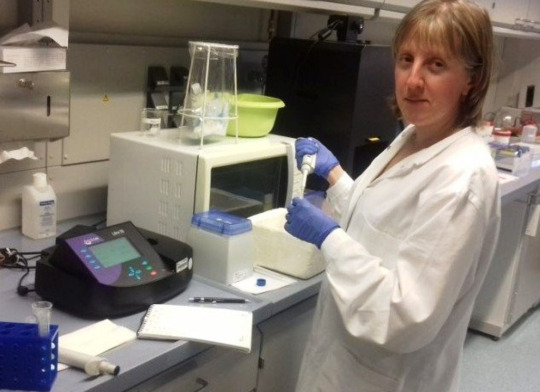
Doctor of Biological Sciences, Associate Professor of Biochemistry and Biotechnology in Vasyl Stefanyk Precarpathian National University. Scientist Mariia Bailiak studies biochemistry and researches the influence of various plants and substances on the aging process. Mariia Bailiak's discoveries concern, for instance, the increase of stress resistance and the general condition of living organisms (and therefore, us and you, and it's good news: stress resistance doesn't hurt anyone), and anti-aging substances. Thanks to her intensive work, Mariia is in the Top 10 successful Ukrainian women scientists.
Olha Brovarets, a biophysicist

Ukrainian biophysicist, Doctor of Physic and Mathematical Sciences, winner of the Scopus Awards Ukraine in the nomination "Best team of scientists who achieved significant scientific results without Western collaborations" and the President of Ukraine Award for Young Scientists, and a leading researcher in the Department of Molecular and Quantum Biophysics Institute of Molecular Biology and Genetics of the National Academy of Sciences of Ukraine. Olha is the youngest doctor habilitatus in Ukraine; she became a doctor at 29. Olha is now 34 years old and she continues to study biophysics: her discoveries give an understanding of the mechanisms of cancer and many other diseases caused by mutations. It was Olha who calculated the pattern of mutations in DNA leading to cancer and many other diseases.
Nana Voitenko, a biologist
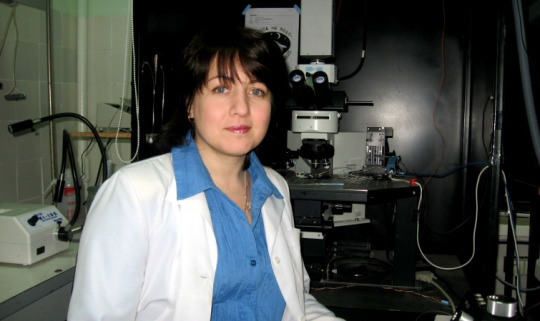
Professor, Doctor of Biological Sciences, neurobiologist, head of the department of sensory signaling of the Bohomolets Institute of Physiology of NAS of Ukraine. Nana Voitenko has been researching pain for more than 20 years. What do we know about pain? For most people on Earth, pain is something they'd like to get rid of as soon as possible if they feel it. Nana Voitenko deals with the nature of pain, as it occurs and spreads in the human's central and peripheral nervous systems. In the laboratory, Voitenko and her colleagues managed to develop an experimental treatment that affects only those cells involved in pain syndromes. Besides, Nana Voitenko is actively promoting science: she's a lecturer at the "Days of Science" initiative, was a lecturer at TED-x Kyiv in 2013, and the organizer of the "Week of Knowledge about the Brain." Science is close, and it's accessible to everyone.
Ella Libanova, an economist

Scientist in socioeconomics, demography, and labor economics, academician of the National Academy of Sciences of Ukraine, Doctor of Economics, Professor, Honored Economist of Ukraine. Ella Libanova is an academician-secretary of the economics department of the National Academy of Sciences of Ukraine and, by the way, the first and only female member of the presidium of the National Academy of Sciences for 102 years of its work. She teaches social statistics at the Faculty of Economics of the Taras Shevchenko National University of Kyiv; introduced a method for measuring human development at the region level, used by the State Statistics Service of Ukraine for annual calculations.
Nina Virchenko, a mathematician

Professor of the Department of Mathematical Analysis and Probability Theory, Doctor of Physic and Mathematical Sciences Nina Virchenko is one of the most famous Ukrainian mathematicians. She is the author of more than 500 scientific and methodological works, including 20 books published in Ukrainian, Russian, English, and Japanese. Nina Virchenko is recognized not only in Ukraine but also abroad; she's a member of the Australian, American, Belgian, Edinburgh, London mathematical societies. In the end, it's not surprising, because mathematics knows no boundaries and recognizes all the achievements, wherever you obtain them.
Nina Virchenko's fate wasn't easy: at 18 in 1948, she was sentenced to 10 years in the Gulag camps for preparing a "political conspiracy, revolt" and participating in the "Ukrainian-nationalist gang." Years in the camps didn't stop the future doctor from achieving her dreams. In 1964, she defended her Ph.D. and her Dr. habil. dissertation in Kyiv in 1988.
Nataliia Vynohrad, an epidemiologist

Epidemiologist, professor, doctor of medical sciences, Nataliia Vynohrad manages the Department of Epidemiology of Lviv National Medical University. She's an expert of the World Health Organization in responding to epidemic threats and the Ministry of Health of Ukraine on epidemiology, an adviser to the Ministry of Emergencies of Ukraine on anti-epidemic protection and biosafety. Agree, you can't find a more relevant profession in 2020-2021. Once an ordinary girl from a village in the Khmelnytskyi region, and now the author of 305 scientific papers, and 8 copyright certificates for inventions and patents of Ukraine, proves that nothing is impossible for a girl who knows what she wants.
Nataliia Polonska-Vasylenko, a historian
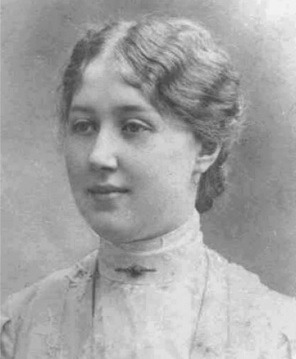
From the early 20th century until the end of her life in the 1970s, our first heroine studied the history and archeology of Ukraine, both in Ukraine and later in exile in Germany and the Czech Republic. In a historically troublesome time for Ukraine, she became one of the leading representatives of the state school in Ukrainian historiography, that is, she promoted the idea of independence and continuity of the Ukrainian historical process. Nataliia Polonska-Vasylenko is the author of almost 200 scientific works on the history of Zaporizhzhia and Southern Ukraine, which remain relevant to this day.
Valentyna Radzymovska, a biologist

One of the most prominent names in our history is Valentyna Radzymovska, a professor, doctor of medical and physiological sciences, founder of the Ukrainian school of physiologists and biochemists, and a public figure. The Soviet authorities repressed Valentyna Radzymovska for her political activities and participation in the Union for the Liberation of Ukraine in the 1930s. However, it didn't prevent her from becoming the author of more than 60 works on biochemistry, pathophysiology, pediatrics, psychoneurology, physiology, and phthisiology. Like the previous scientist in our article, she left Ukraine in 1945, emigrating first to Germany and then to the United States.
Radzymovska contributed hugely to the study of tuberculosis and its treatment in children.
Nina Morozhenko, a physicist
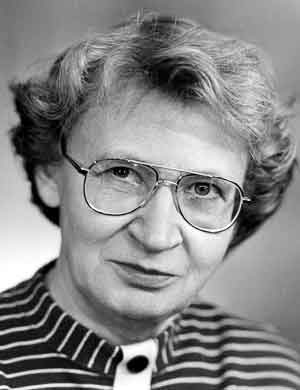
Although the sun is the closest star to us, it still hides many fascinating mysteries. Ukrainian astronomer, helio physicist, doctor of physic and mathematical sciences, author of 56 scientific works, Nina Morozhenko devoted her entire life to studying the structure of our guide light and the processes taking place on it. After all, everything happening on the Sun affects many areas of human activity. Without studying the sun, it's impossible to understand not only what the future holds for our civilization but also what is happening in space, i.e. on the distant stars the humanity is so eager to reach. Nina Morozhenko's scientific works on solar prominences were the first in the world and gave rise to scientific research by helio physicists from many countries. The Ukrainian researcher's significant contribution to the physics of the sun once again demonstrates that physics isn't a purely "male" science.
192 notes
·
View notes
Text
Researchers reporting in the journal Current Biology on December 4 have found the earliest-known fossil mosquito in Lower Cretaceous amber from Lebanon. What's more, the well-preserved insects are two males of the same species with piercing mouthparts, suggesting they likely sucked blood. That's noteworthy because, among modern-day mosquitoes, only females are hematophagous, meaning that they use piercing mouthparts to feed on the blood of people and other animals.
"Lebanese amber is, to date, the oldest amber with intensive biological inclusions, and it is a very important material as its formation is contemporaneous with the appearance and beginning of radiation of flowering plants, with all what follows of co-evolution between pollinators and flowering plants," says Dany Azar of the Nanjing Institute of Geology and Paleontology at the Chinese Academy of Sciences and the Lebanese University.
"Molecular dating suggested that the family Culicidae arose during the Jurassic, but previously the oldest record was mid-Cretaceous," says André Nel of the National Museum of Natural History of Paris (Muséum National d'Histoire Naturelle de Paris). "Here we have one from the early Cretaceous, about 30 million years before."
The Culicidae family of arthropods includes more than 3,000 species of mosquitoes. The new findings suggest that male mosquitoes in the past fed on blood as well, according to the researchers. They also help to narrow the "ghost-lineage gap" for mosquitoes, they say.
Continue Reading.
184 notes
·
View notes
Note
glasses lover here again, and i am nearly dying to know more about chesters personality!! (seriously i think ive got a problem with how much i adore his design,) what’s he like when not around mc? ^^ sorry if this was asked or answered already!
honestly i wrote a bunch of stuff for him, he is very serious about studying but when he has time (very rarely, he overworks himself a lot!) i just imagine him as very grandma coded, because i wrote that he is interested in embroidery, botany and miniatures
he likes embroidery because it's something he can do without thinking much when he is stressed and it helps him to stop thinking so much
while he loves studying about molecular biology he also sometimes misses the plants parts of biology too! he also likes taking care of them
and he just looooves anything small, specially small animals, he finds them very cute
27 notes
·
View notes
Text
🔬🌿 Diving Deeper into the Intricacies of Bioenergetics 🌿🔬
Hey there, science enthusiasts and curious minds! Today, we're embarking on a journey into the fascinating realm of bioenergetics, where the magic of energy transformation in living organisms unfolds. Buckle up because we're about to delve into the nitty-gritty of this captivating field!
The Energy Currency: ATP
At the heart of bioenergetics lies adenosine triphosphate (ATP), often dubbed the "energy currency" of cells. It's like the dollars in your wallet, except cells use ATP to facilitate all sorts of biochemical processes. Think of it as the universal energy medium that powers life itself.
The Energy Factory: Cellular Respiration
Now, let's talk about how ATP is made. In eukaryotic organisms like us, cellular respiration is the superstar process. It comprises glycolysis, the citric acid cycle (Krebs cycle), and oxidative phosphorylation. During these metabolic pathways, energy is extracted from organic molecules, such as glucose, and transformed into ATP. It's like a power plant for the cell, with each step meticulously orchestrated.
Expenditure and ATP Hydrolysis
But cells aren't just about making energy; they're also extravagant spenders. When cells perform work or carry out essential functions, they hydrolyze ATP into adenosine diphosphate (ADP) and inorganic phosphate (Pi). This process releases energy that fuels various cellular activities, from muscle contractions to active transport across cell membranes. It's like using cash to pay for services, and ATP is the bank where cells withdraw their energy.
Thermodynamics and Bioenergetics
Now, let's get a bit nerdy with thermodynamics. Bioenergetics pays homage to the laws of thermodynamics, particularly focusing on entropy and enthalpy. These principles help explain how energy flows within biological systems and how it's harnessed and regulated to keep life ticking. It's a bit like maintaining a delicate energy balance, ensuring that the cellular economy remains stable.
References to Dive Deeper
If you're eager to explore bioenergetics further, here are some fantastic references to get your intellectual gears turning:
1. "Molecular Cell Biology" by Lodish et al.
2. "Molecular Biology of the Cell" by Alberts et al.
3. "Bioenergetics 4" by Nicholls and Ferguson.
So, there you have it! Bioenergetics is like the electrifying symphony of life, with ATP as the conductor. The next time you marvel at the complexity of living organisms, remember that it's all powered by the awe-inspiring world of bioenergetics! 🌿🔬✨ #

#science#biology#college#education#school#student#medicine#doctors#health#healthcare#bioenergy#biochemistry#knowlegde#molecular biology
39 notes
·
View notes
Text
THE TREE OF NATURAL SCIENCE
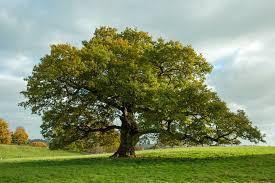
LIFE SCIENCE -> Any science concerned with the study of living organisms
THE BRANCHES OF LIFE SCIENCE:
BIOLOGY
This branch of life science will study living organisms, and it will be divided into many specialized branches that cover their morphology, physiology, anatomy, behavior, origin, and distribution.
THE BRANCHES OF BIOLOGY:
CONSERVATION
This branch of biology will study environmental conservation and biodiversity on Earth.
■Wildlife Management is a branch of conservation that will specialize in the concern for the management process influencing the interaction between wildlife, its habitat, and people in order to achieve the pre-defined impact.
ECOLOGY
This branch of biology will study how organisms interact with the environment around them.
■Autecology is a branch of ecology that will specialize in studying a specific organism of a species.
■Synecology is a branch of ecology that will specialize in studying an ecosystem.
EVOLUTION
This branch of biology will study any evolutionary process with its regard to diversification and adaptation over many years.
GENETICS
This branch of biology will study genes, genetic variation, and heredity.
MARINE BIOLOGY
This branch of biology will study marine organisms.
■Ichthyology is a branch of marine biology that will specialize in studying fish.
MEDICINE
This branch of biology will study managing the diagnosis, prognosis, prevention, treatment, palliation of an injury or disease, and promoting the health of a patient through such mentioned practice.
■Psychiatry is a branch of medicine that will devote itself to the diagnosis, prevention, and treatment of deleterious mental conditions.
□Addiction psychiatry is a branch of psychiatry that will focus on the evaluation, diagnosis, and treatment of people who have one or more disorders related to addiction.
□Forsenic psychiatry is a branch of psychiatry that will be applied in a legal context involving any civil, criminal, correctional, regulatory, or legislative issues.
□Neuropsychiatry is a branch of psychiatry that will examine both organic and psychological aspects as a cause for illness.
□Occupational psychiatry is a branch of psychiatry that will use the extension of psychiatric knowledge and skill to the day-to-day functioning of individuals in the workplace and their organizations, with the goal of helping both function better.
□Geriatric psychiatry is a branch of psychiatry that will center itself on prevention, evaluation, diagnosis, and treatment of mental and emotional disorders in the elderly.
□Child psychiatry is a branch of psychiatry that will be concerned with the study and treatment of mental, emotional, and behavioral disorders of childhood.
□Adolescent psychiatry is a branch of psychiatry that will be interested in the diagnosis and the treatment of disorders of thinking, feeling, and/or behavior affecting children, adolescents, and their families.
MOLECULAR BIOLOGY
This branch of biology will study the chemical structure and any biological process of a molecule.
PHYSIOLOGY
This branch of biology will study how the human body functions.
BOTANY
This branch of biology will study plants.
■Mycology is a branch of botany that will focus on the study of fungi, including their taxonomy, genetics, physiology, and any ecological role.
ZOOLOGY
This branch of biology will study the entire animal kingdom.
■Anthrozoology is a branch of zoology that will study the interaction between any human and another animal.
■Arachnology is a branch of zoology that will handle the study of spiders and any related species known as arachnids.
■Cetology is a branch of zoology that will be interested in the study of marine mammals.
■Entomology is a branch of zoology that will focus on the study of insects.
1. COLEOPTEROLOGY is the sub-branch of entomology that will concern itself with the study of the beetle.
2. DIPTEROLOGY is the sub-branch of entomology that will study all types of flies.
3. ISOPTEROLOGY is the sub-branch of entomology concerned with the study of the termite.
MICROBIOLOGY
This branch of biology will study any microorganism.
CHEMISTRY ->
The study of the identification of the substances that which matter is comprised; the investigation of their properties and the methods in which they interact, combine, and change; and the use of these processes to form new substances.
THE BRANCHES OF CHEMISTRY:
ORGANIC CHEMISTRY
The branch of chemistry that's concerned with the study of an organic substance and compound.
INORGANIC CHEMISTRY
The branch of chemistry that will examine the properties and behavior of inorganic compounds, which would include any metal, mineral, and organometallic compound.
PHYSICAL CHEMISTRY
The branch of chemistry concentrated on the application of technique and theory of physics to the study of the chemical system.
ANALYTICAL CHEMISTRY
The branch of chemistry interested in obtaining, processing, and communicating information about the composition and structure of matter.
STEREOCHEMISTRY
The branch of chemistry illustrating the three-dimensional arrangement of atoms and molecules and its effect on the chemical reaction.
BIOCHEMISTRY
The branch of chemistry that will evaluate the chemical and physicochemical processes and substances that occur within the living organism.
GEOCHEMISTRY
The branch of chemistry that will study the chemical composition of the earth and its rocks and minerals.
FORENSIC CHEMISTRY
The branch of chemistry that will use the application of chemistry to help law enforcement catch their criminal.
PHYSICS ->
The study of the structure of matter and how the fundamental constituents of the universe interact.
THE BRANCHES OF PHYSICS:
OPTICS
The branch of physics that will study the sense of sight and the behavior of light, or the properties of transmission and deflection of other forms of radiation.
ELECTROMAGNETISM
The branch of physics that will investigate the interaction of electric currents or fields and magnetic fields.
RELATIVITY
The branch of physics that will examine special relativity and general relativity. For example, special relativity will apply to all physical phenomena in the absence of gravity, but general relativity will explain the law of gravitation and its relation to any force of nature.
THERMODYNAMICS
The branch of physics that will illustrate the energy and work of a system.
ACOUSTICS
The branch of physics that will vocalize the study of sound for us to hear it.
QUANTUM PHYSICS
The branch of physics that will focus on the study of matter and energy at the most fundamental level.
MECHANICS
The branch of physics that will examine the relationship between force, matter, and motion among a physical object. To define this, this force, when applied to an object, will result in the displacement or change of an object's position relative to its environment.
EARTH SCIENCE ->
See previous post regarding this topic.
37 notes
·
View notes
Text
130 Day Productivity Challenge!
24 April, 2024 - Day 124

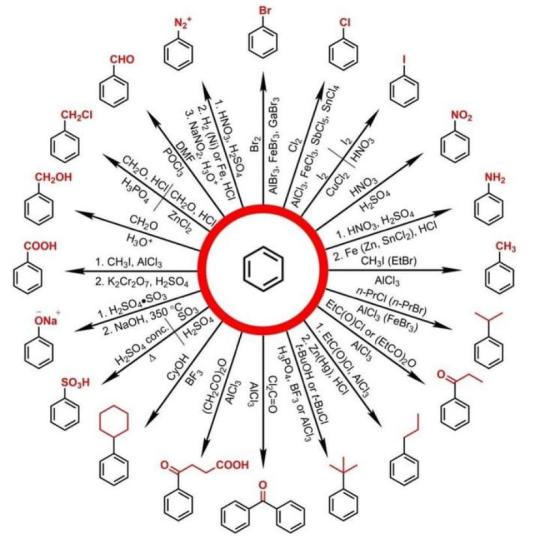
I revised NEET 2017 paper and marked some important questions.
I solved Exemplar questions of Mole Concept, Atomic Structure, Periodicity, Units and Measurements and Motion in a Stright Line.
I revised my notes of Principles of Inheritance, Molecular Basis of Inheritance, Plant Kingdom and read through the NCERT for Evolution for Biology Set-5.
I solved questions on Electrochemistry, Redox Reactions, Thermodynamics, KTG, Plant Kingdom, Morphology and Anatomy of Flowering Plants.
I feel winded, understimulated and like a failure and it sucks that a day so close to 5 May feels so and deters me so. I hope to bounce back to normalcy tomorrow and slide back into the path to achieve the potential goal.
Hope your day went better💛
13 notes
·
View notes
Note
Not much monster fucking but it's this fantasy I have and crave that is about deeply connecting and understanding aliens beyond the limits of language, biology and everything else. Just two brains trying to make sense of one another through any means.
Imagine you're an astronaut and your spaceship is found by aliens who take you in kindly. Neither of you can understand one another and have to communicate with drawings. First and foremost you have to ask for them to refill your tank, give you water and food. You have to use chemistry to get your point across. They're probably brilliant and drawing the molecular make up of what you want is enough for them to understand.
Then you get to pour your heart out drawing all about life on earth and watch them take notes and discuss it among themselves. Like you get to draw different things ranging from organisms to geology and at the same time refer to their periodic table that they offer you to tell them what each thing is made up of. You get to tell them all about birds, plants, fish, mammals, reptiles, humans and their diversity etc in the nerdiest ways possible and it's food for them! it'd be so euphoric if they fully understand you and do their equivalent of deep understanding nods.
Explaining feelings and social acts would be a greater challenge but the most rewarding, if you get to learn theirs and they learn yours. Imagine an alien trying their hardest to smile despite not having the muscles or you trying so hard to make a rumbling sound for them!
Then at the end for the sake of science, you all fuck
.
52 notes
·
View notes
Photo
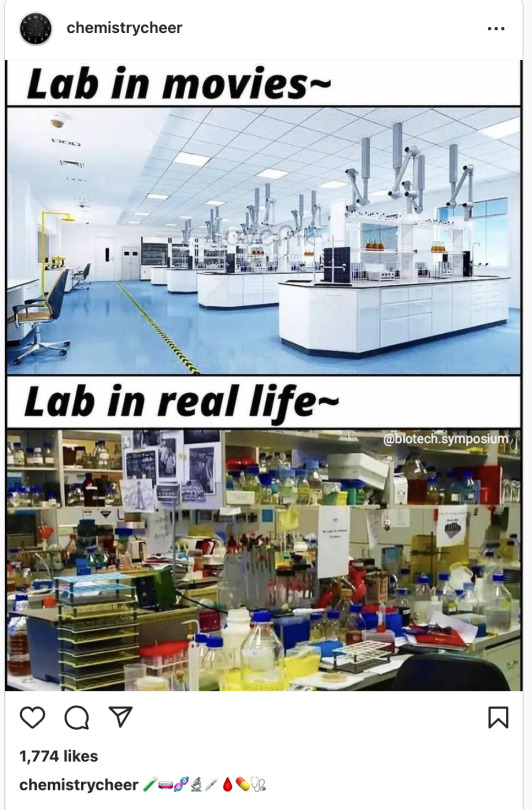
As a biologist who used to work in a lab, I can 100% confirm that this is true.
(from @chemistrycheer on Instagram)
#science#mad science#laboratory#workplace#workplace humor#expectation versus reality#biology#molecular biology#biologist#plant biology#Science and Technology#scientist
38 notes
·
View notes
Text

#English#language editing#research#journal#manuscript#paper#high impact factor#publishing#international#science#biology#biochemistry#molecular biology#plant#animal#earth
0 notes
Text
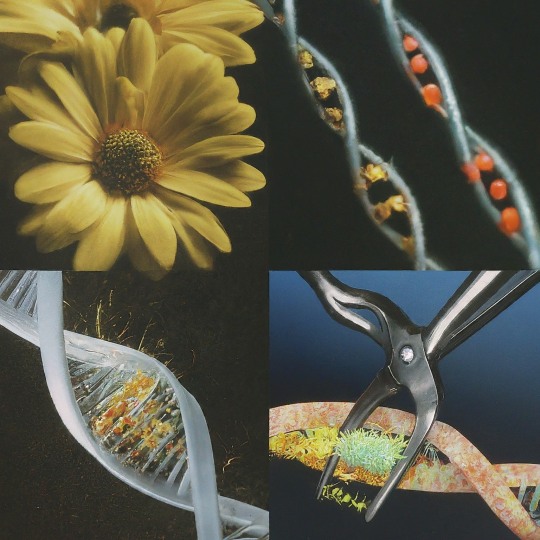
A snip, a splice : Power of rDNA Technology
Deoxyribonucleic acid (DNA), the blueprint of life, holds the secrets to the intricate workings of every living organism. But what if we could manipulate this blueprint, adding, removing, or tweaking its code? This revolutionary concept forms the core of recombinant DNA (rDNA) technology, a powerful tool that has transformed biology and medicine.
The story starts in the early 1970s with two brilliant scientists; Stanley Cohen at Stanford University and Herbert Boyer at the University of California, San Francisco. Cohen, a microbiologist, had been studying plasmids – small circular DNA molecules found in bacteria. Boyer, a biochemist, was an expert on restriction enzymes – molecular scissors that could cut DNA at specific sequences. Their collaboration proved groundbreaking. They envisioned combining these tools to create the first ever recombinant DNA molecule. Cohen provided the plasmids, which would act as vectors to carry foreign DNA into host cells. Boyer, on the other hand, used restriction enzymes to cut both the plasmid and the desired foreign DNA, allowing them to be pieced together. Through meticulous experimentation, they successfully created the first recombinant DNA molecule, forever altering the course of biology.
Cohen and Boyer's work wouldn't have been possible without the earlier discoveries of restriction enzymes. These "molecular scissors" were independently identified by three separate research groups in the 1960s. Werner Arber in Switzerland, along with Hamilton Smith and Daniel Nathans in the US, unraveled the role of restriction enzymes in bacterial defense mechanisms. These enzymes helped bacteria defend against invading viruses by cutting up their foreign DNA. Recognizing the potential of these "genetic scalpels," the groundwork was laid for their application in rDNA technology.
Here's a simplified breakdown of the rDNA process:
Isolation of DNA: The journey starts with isolating DNA from a donor organism.
Cleavage with Restriction Enzymes: Specific enzymes cut the DNA at defined sequences.
Selection of Vector: A carrier molecule (often a plasmid) is chosen to transport the recombinant DNA.
Ligation: The DNA fragments and vector are stitched together using DNA ligase, an enzyme.
Transformation: The recombinant DNA enters a host cell (usually bacteria or yeast).
Selection and Expression: The transformed cells are selected, and the gene of interest is expressed, leading to the desired protein production.
Since its inception, rDNA technology has played a pivotal role in several groundbreaking advancements. Let's take a whirlwind tour through some of the most significant moments in R-DNA history:
1978: Birth of Insulin on the Factory Floor: Scientists achieved a feat of genetic engineering by using R-DNA to produce human insulin in bacteria. This marked a turning point for diabetics, offering a readily available and more consistent source of this life-saving hormone.
1980s: Gene Wars and the Rise of GMOs: The 1980s saw the development of genetically modified organisms (GMOs). Plants were engineered with genes for insect resistance or herbicide tolerance, sparking debates about the safety and ethics of this technology. R-DNA research continues to be at the forefront of discussions regarding genetically modified foods.
1990s: The Human Genome Project Sets Sail: This ambitious international project aimed to sequence the entire human genome. R-DNA techniques played a crucial role in deciphering the 3 billion letters of our genetic code, opening doors for personalized medicine and a deeper understanding of human health and disease.
2000s: Gene Therapy Takes Center Stage: The first successful gene therapy trials for inherited diseases like severe combined immunodeficiency (SCID) took place. R-DNA technology offered a glimmer of hope for treating genetic disorders by introducing healthy genes to replace defective ones.
2010s and Beyond: CRISPR Takes Over: The emergence of CRISPR-Cas9, a revolutionary gene editing tool based on R-DNA principles, has ushered in a new era of genetic manipulation. With unprecedented precision, scientists can now edit genes in various organisms, holding immense potential for gene therapy, crop improvement, and even the eradication of diseases.
But with great power comes great responsibility, and R-DNA raises a host of ethical concerns.Tinkering with the building blocks of life carries the risk of unintended consequences. Engineered genes could escape and disrupt ecosystems, or modified organisms could have unforeseen health effects. The ability to edit human genes opens the door to designer babies, raising questions about social equity and the potential misuse of the technology for eugenics.
Who Controls the Tools? Access to R-DNA technology could be restricted to wealthy nations or corporations, exacerbating existing inequalities. Biosecurity is also a concern, as the technology could be misused for bioterrorism. Creating entirely new organisms forces us to confront what it means to be "natural." Should we modify plants and animals for human benefit, or preserve their original forms? R-DNA technology is a powerful tool, and we must have open discussions about its ethical implications. Scientists, policymakers, and the public all need to be involved in shaping the future of this technology. As we move forward, open dialogue and collaboration between scientists, policymakers, and the public are crucial to ensure the safe and ethical application of this powerful technology.
The journey of rDNA technology is a testament to human ingenuity and its potential to reshape our world. From decoding the secrets of life to creating solutions for healthcare, agriculture, and beyond, rDNA technology continues to evolve, promising a future filled with exciting possibilities.
#science sculpt#life science#science#molecular biology#biology#biotechnology#artists on tumblr#dna#double helix#genetics#recombinant#genetic engineering#insulin#research#education#learning#academics#scientific research#scientific illustration#medical science#scifi#daily dose of science#scientific advancements#scientific tools#medical school
7 notes
·
View notes
Text
It's a simple question that sounds a little like a modest proposal: "Should we cut down all the oak trees?" asks Tom Sharkey, a University Distinguished Professor in the Plant Resilience Institute at Michigan State University.
Sharkey also works at the MSU-Department of Energy Plant Research Laboratory and in the Department of Biochemistry and Molecular Biology.
To be clear, Sharkey isn't sincerely suggesting that we should cut down all the oaks. Still, his question was an earnest one, prompted by his team's latest research, which was published in the journal Proceedings of the National Academy of Sciences.
The team discovered that on a warming planet, plants like oaks and poplars will emit more of a compound that exacerbates poor air quality, contributing to problematic particulate matter and low-atmosphere ozone.
The rub is that the same compound, called isoprene, can also improve the quality of clean air while making plants more resistant to stressors including insects and high temperatures.
"Do we want plants to make more isoprene so they're more resilient, or do we want them making less so it's not making air pollution worse? What's the right balance?" Sharkey asks. "Those are really the fundamental questions driving this work. The more we understand, the more effectively we can answer them."
Continue Reading.
121 notes
·
View notes
Text
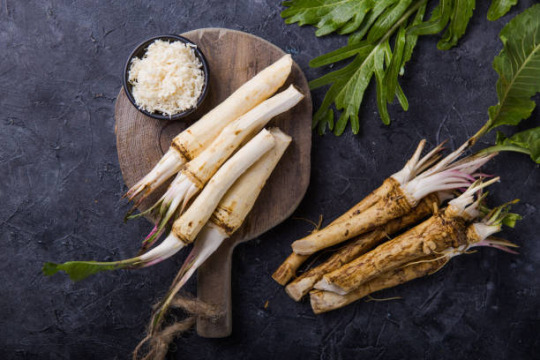
Horseradish (Armoracia rusticana, Brassicaceae - Mustard Family)
an extended version of this materia media can be found on the Patreon - where I share some gastronomic/culinary commentaries on horseradish
"The root's potent smell can be attributed to allyl isothiocyanate, or Mustard oil, which is released when the plant's skin is broken or disturbed. Similar to other members of the Brassicaceae family, this constituent is also found in Brussels sprouts, Mustard, and Turnips."
"In Greek mythology, the Delphic Oracle told Apollo, 'The Radish is worth its weight in lead, the Beet its weight in silver, the Horseradish its weight in gold.'"
"To a worm in a horseradish, the world is a horseradish” - Yiddish Proverb
Gardening: full sun to part shade; well draining loose or sandy soil; regular water; room to spread and grow deep, often takes over more space than expected; thrives even when neglected; herbaceous perennial
Native Region: Russia & Eastern Ukraine
Season: autumn and winter (hardy to zone 5)
Affinity: sinuses, lungs, digestive system, circulation
Parts: roots and leaves
Medicinal: fire cider/oxymels, cold-water infusion, succus (fresh juice), cough syrup, poultice for sprains/injuries, tincture, culinary measures
"Grated horseradish mixed with honey [or vegan alternative]. After mixing, allow to stand to take off sharp taste. The [sweetener] is only used to make it more palatable. 2/3 horse-radish and 1/3 [sweetener], or to suit the taste. The ordinary radish, especially the black radish, may also be used the same way, or finely sliced and eaten alone as a salad. For consumptives who cough without spitting, give a spoonful every once in a while." - Special "Mucus-Eliminator" Recipe in Arnold Ehret's Mucusless Diet Healing System
^I like to add grated orange peel to help make it more manageable to taste^
Actions: diuretic, stimulant, expectorant, rubefacient, aphrodisiac, digestive, antiseptic (laxative), aperient, anthelmintic, emetic (in high doses)
‼when you cut into horseradish, its pungent smell can irritate the eyes and nasal passages, so it's better to do in a well-ventilated area or outside. It is more potent in its effect than onions. The taste is also very pungent, so you don't need much.
Energetic Uses (eg. flower essence, elemental rituals): FIRE ELEMENT - balance fiery nature, excite inner fire, move you beyond sense of being stuck/helpless, shine a light on blockages, release old patterns or thoughtforms
Indications: hoarse, persistent, dry cough; rheumatism; tuberculosis; kidney stones; parasite infections; cold; congestion
Analogs: wasabi, radish, mustard, brussels sprouts, moringa (Moringa oleifera)
Traditional Uses:
Ancient Greeks & Romans: rub for lower back pain or menstrual cramps, aphrodisiac
Middle Ages: asthma, arthritis, cancer, toothaches
Jewish: bitter herb for Passover seder
Native Americans: toothaches, menstrual cramps
British: accompaniment to beef and oysters, cordials
Scurvy preventative
Treatment for tuberculosis
Restoring color and freshness to skin (cosmetic usage)
Modern Ideas:
"The enzyme horseradish peroxidase (HRP) is a useful
tool for detecting antibodies in the molecular biology field."
"In 2008, researchers reported that they had developed a fire alarm for the deaf and hard of hearing by harnessing the strong smell of horseradish."
"Researchers from Pennsylvania State University announced in 1995 that according to their studies, using horseradish may help purify wastewater and tainted soils."
Sources: a b c d e
#txt#dream garden#herbarium#horseradish#Armoracia rusticana#food centric herbalism#herbalism#gardening#materia medica#sidewalkchemistry
19 notes
·
View notes
Text
68 notes
·
View notes